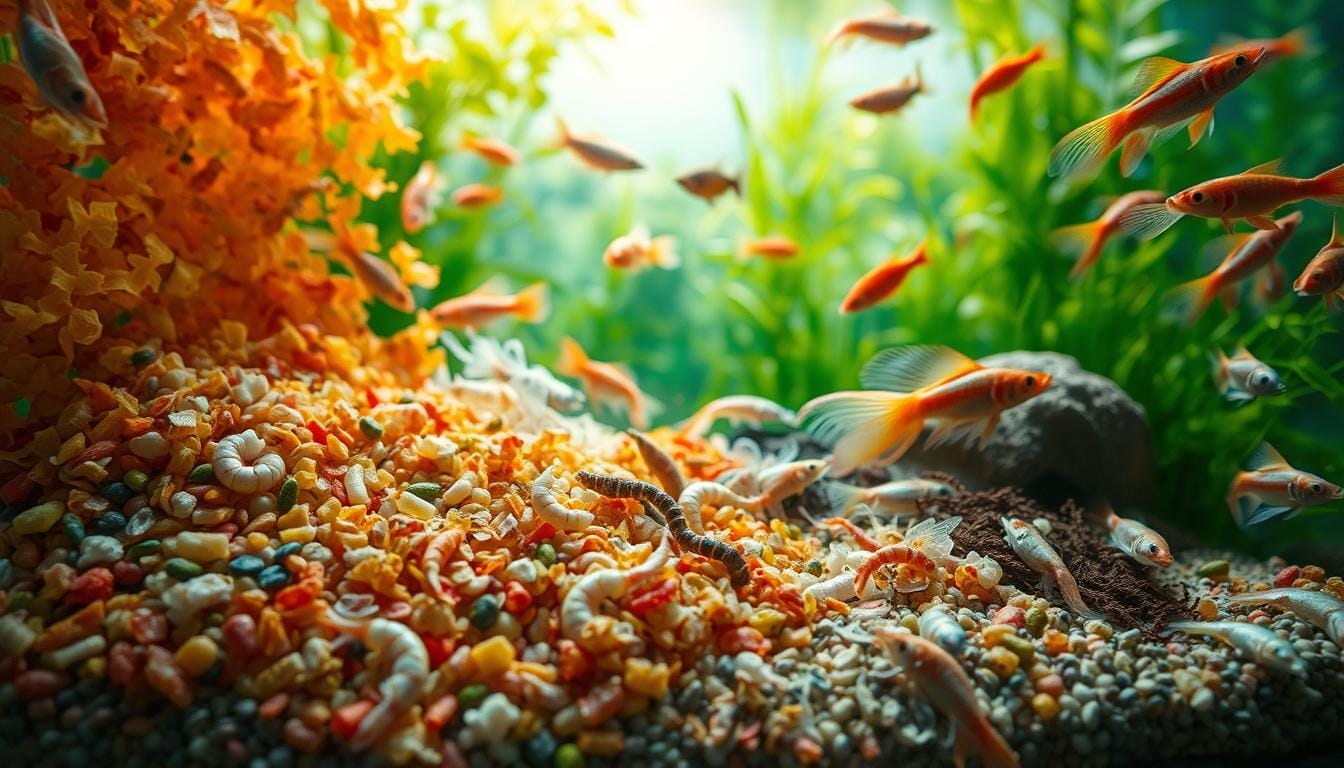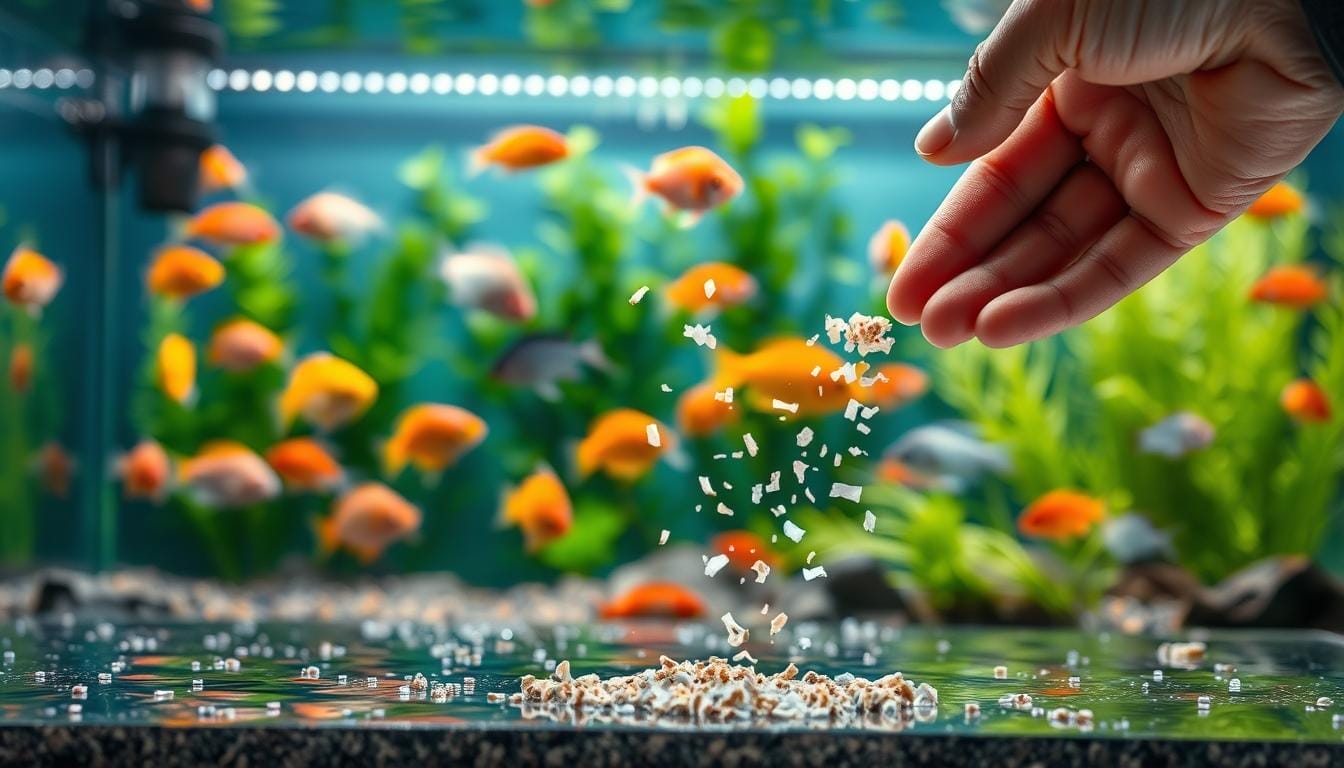
homemade fish food Recipes for Your Aquarium’s Health

Did you know aquarium enthusiasts spend over $500 annually on commercial fish diets? Yet many store-bought options lack the tailored nutrition aquatic pets need to thrive. By creating customized meals, you’ll not only save money but also boost your tank’s vitality in ways pre-packaged products can’t match.
Preparing your own recipes lets you combine exactly what your aquatic friends require. Imagine blending fresh ingredients like shrimp, veggies, and vitamins into perfect bites. You control texture sizes—crushed for tiny species or chunky for larger ones—ensuring every meal gets eaten, not stuck in gravel.
This approach keeps water cleaner by eliminating preservatives that cloud tanks. You’ll adapt meals for breeding pairs, sensitive species, or health recoveries. Best part? It costs less than half the price of frozen store brands.
With basic kitchen tools and 30 minutes monthly, you can craft nutrient-packed dishes. Your pets will display brighter colors and more energy. Ready to transform how you feed your underwater family?
The Benefits of Homemade Fish Food for Your Aquarium
Creating meals for your aquatic pets unlocks benefits commercial options simply can’t match. You’ll gain precision in nutrition while saving money – a win-win for both your wallet and tank ecosystem.
Budget-Friendly Nutrition Solutions
Store-bought options cost $10 per pound on average, while DIY mixtures using frozen shrimp and salmon run under $4. This 60% savings adds up quickly, especially when feeding multiple tanks. One batch using quality ingredients:
- Lasts over 30 days in freezer cubes
- Contains 55-65% protein from meat sources
- Eliminates preservatives found in packaged foods
Tailored Dietary Precision
You control every ingredient – perfect for sensitive species or breeding pairs. Mix fresh algae with brine shrimp for picky eaters, or add paprika for color enhancement. This approach:
- Prevents wasted food sinking into gravel
- Allows adjusting recipes seasonally
- Ensures optimal nutrient absorption
Proper storage in airtight containers maintains freshness between feedings. You’ll see visible results within days – vibrant colors, active behavior, and cleaner water from reduced additives.
Essential Ingredients and Tools for DIY Fish Food
Building nutrient-rich meals starts with smart ingredient choices and the right equipment. Let’s explore how to assemble components that cater to diverse dietary needs while keeping prep work efficient.
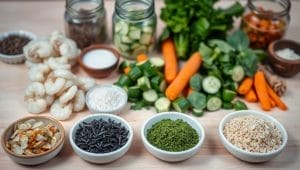
Selecting Fresh, Frozen, and Alternative Ingredients
Prioritize frozen proteins like mysis shrimp and bloodworms – they retain 92% more nutrients than freeze-dried options. Combine these with fresh shellfish medleys from local markets for cost-effective variety. A balanced recipe might include:
- 12 cubes of spirulina-enriched brine shrimp
- 1/2 teaspoon powdered algae for herbivores
- 1.5 ounces plain gelatin as binder
Don’t overlook supplements! Nori seaweed adds essential fiber, while crushed Formula Pellet food boosts vitamin content. Always drain canned salmon thoroughly to prevent oily water buildup.
Choosing and Using Food Processors and Blenders
Your appliance’s power determines texture quality. A 450-watt blender creates smooth purees for small species, while processors handle chunky mixes for larger pets. Key features to seek:
- Stainless steel blades for frozen ingredients
- Multiple speed settings
- Easy-clean design
Process meats and veggies separately before combining. This prevents over-blending delicate components. Freeze portions in ice cube trays – each cube feeds a 20-gallon tank for two days.
Step-by-Step How-To Guide for Making DIY Fish Food
Transform your kitchen into a nutrition lab with this straightforward method for creating balanced, aquarium-safe dishes. You’ll master ingredient prep, blending techniques, and smart storage solutions in three key phases.
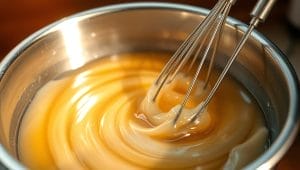
Ingredient Prep Like a Pro
Begin by steaming frozen peas and carrots according to package directions – this softens them without losing vitamins. Process salmon chunks in a mini-chopper until they resemble coarse sand. Combine 7.5 ounces of pumpkin puree with 1/2 teaspoon garlic powder and a pinch of paprika for color enhancement.
Mastering the Gel Blend
Heat your protein-algae mix in a pan until steaming. Separately, dissolve four gelatin packets in cold water for five minutes, then stir into boiling liquid until clear. Cool both mixtures to 120°F before blending – this creates the perfect sticky texture for binding.
Pour the warm blend into quart-sized bags, flattening to 1/8-inch thickness. Freeze horizontally for easy portioning. Break off coin-sized pieces as needed, thawing for 90 seconds before feeding. Your aquatic pals get fresh meals, and you avoid freezer burn waste!
- Use silicone molds for varied bite sizes
- Label bags with preparation dates
- Rotate frozen stock every six weeks
Homemade Fish Food: Creating Nutritious Recipes for Vibrant Aquariums
Your aquarium’s menu becomes a powerful tool when adapted to specific needs. Whether nurturing fry or enhancing colors, strategic adjustments transform standard recipes into targeted solutions.
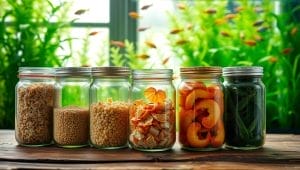
Texture and Buoyancy Customization
Adjust gelatin ratios to match feeding behaviors. Use 4 packets for firm cubes that sink slowly – ideal for bottom dwellers. Reduce to 2 packets for softer gels that mid-water species can nibble. For surface feeders, fold whipped cream into cooled mixtures before setting to create floating morsels.
Young aquatic life benefits from calcium-rich additives. Blend steamed bone meal into recipes at 1/4 teaspoon per cup. Cod liver oil (3 tablespoons) supports rapid growth without clouding water. Always strain oils through cheesecloth to remove residue.
Smart Feeding Practices
Portion size matters more than frequency. Offer pea-sized amounts initially, increasing only if pets finish within five minutes. This prevents uneaten chunks from decaying in gravel. Use these techniques:
- Disable filtration pumps during meals
- Target feed shy species with turkey basters
- Store excess in dated silicone ice trays
Color enhancement comes naturally with astaxanthin – add 1/8 teaspoon to brighten red hues. Breeding pairs thrive on fatty mixes containing 15% salmon puree. Remember: variety prevents nutritional gaps while keeping mealtimes exciting!
Final Strategies for Sustainable and Healthy Fish Feeding
Your aquarium thrives when meals align with natural rhythms. Start mornings by placing pellet blends in a Mandarin Diner – this keeps food contained for shy bottom dwellers. Offer hatched baby brine shrimp later in the day, using 1 teaspoon of eggs per dose for protein-packed snacks.
Clip fresh nori sheets to tank glass every couple days for grazing species. Evening feedings work best for frozen gel cubes – thaw a half-cup portion and watch active eaters swarm. Alternate with phytoplankton pours every 48 hours, but always check its scent; spoiled batches turn sour and harm water quality.
Store refrigerated meals in dated containers to track freshness. Remove uneaten pieces within 10 minutes using a siphon tube – this prevents decay and keeps ammonia levels safe. Adjust amounts seasonally, reducing portions if algae grows naturally on tank surfaces.
With these routines, you’ll maintain vibrant colors and crystal-clear water. Remember: consistency beats complexity. Your pets will reward you with lively behavior and thriving ecosystems!
FAQ
Can I use frozen vegetables in DIY aquarium meals?
Yes! Frozen peas, spinach, or zucchini work well after thawing. Just ensure they’re free from additives or sauces. Blanching softer veggies helps maintain texture for easier blending.
How do I prevent the mixture from clouding tank water?
Strain excess liquid after blending and use agar or gelatin to bind ingredients tightly. Freeze portions into cubes or thin sheets – this reduces crumbling during feeding.
What protein sources suit carnivorous species?
A> Brine shrimp, salmon fillets, or scallops provide excellent nutrition. For smaller fish, grind proteins into fine powder using a coffee grinder before mixing with other ingredients.
Can I add vitamins to homemade recipes?
Absolutely. Crush aquarium-specific vitamin supplements into powder and blend them into your base mixture. Garlic juice or spirulina powder also boosts immunity naturally.
How long does DIY food last in storage?
Frozen cubes stay fresh for 2-3 months. Store them in airtight containers or silicone molds. Thaw only what you’ll use within 48 hours to avoid bacterial growth.
Will herbivores accept meat-based blends?
Focus on algae wafers, blanched kale, or nori sheets for plant-eaters. Mix these with a small amount of unflavored gelatin to create sinking pellets that mimic their natural diet.
Why does my gel mixture fail to solidify?
Check your agar/gelatin-to-water ratio. Use 1 teaspoon of powder per cup of liquid. If issues persist, briefly simmer the mixture while stirring constantly before pouring into molds.





